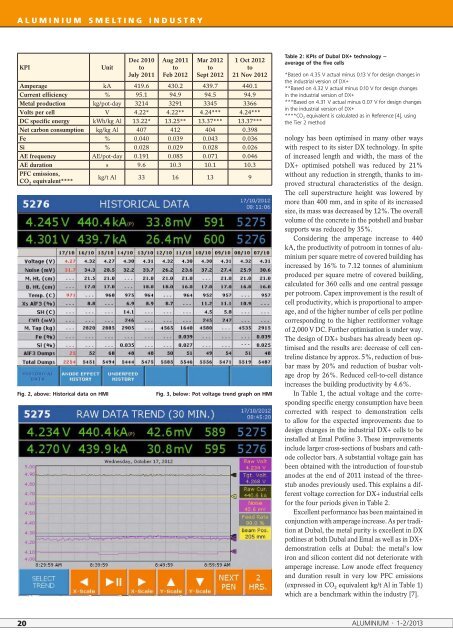special - ALUMINIUM-Nachrichten – ALU-WEB.DE
special - ALUMINIUM-Nachrichten – ALU-WEB.DE
special - ALUMINIUM-Nachrichten – ALU-WEB.DE
You also want an ePaper? Increase the reach of your titles
YUMPU automatically turns print PDFs into web optimized ePapers that Google loves.
<strong><strong>ALU</strong>MINIUM</strong> SMELTING INDUSTRY<br />
KPI<br />
Unit<br />
Dec 2010<br />
to<br />
July 2011<br />
Aug 2011<br />
to<br />
Feb 2012<br />
Mar 2012<br />
to<br />
Sept 2012<br />
1 Oct 2012<br />
to<br />
21 Nov 2012<br />
Amperage kA 419.6 430.2 439.7 440.1<br />
Current efficiency % 95.1 94.9 94.5 94.9<br />
Metal production kg/pot-day 3214 3291 3345 3366<br />
Volts per cell V 4.22* 4.22** 4.24*** 4.24***<br />
DC specific energy kWh/kg Al 13.22* 13.25** 13.37*** 13.37***<br />
Net carbon consumption kg/kg Al 407 412 404 0.398<br />
Fe % 0.040 0.039 0.043 0.036<br />
Si % 0.028 0.029 0.028 0.026<br />
AE frequency AE/pot-day 0.191 0.085 0.071 0.046<br />
AE duration s 9.6 10.3 10.1 10.3<br />
PFC emissions,<br />
CO 2 equivalent****<br />
kg/t Al 33 16 13 9<br />
Fig. 2, above: Historical data on HMI<br />
Fig. 3, below: Pot voltage trend graph on HMI<br />
Table 2: KPIs of Dubal DX+ technology <strong>–</strong><br />
average of the five cells<br />
*Based on 4.35 V actual minus 0.13 V for design changes in<br />
the industrial version of DX+<br />
**Based on 4.32 V actual minus 0.10 V for design changes<br />
in the industrial version of DX+<br />
***Based on 4.31 V actual minus 0.07 V for design changes<br />
in the industrial version of DX+<br />
****CO 2 equivalent is calculated as in Reference [4], using<br />
the Tier 2 method<br />
nology has been optimised in many other ways<br />
with respect to its sister DX technology. In spite<br />
of increased length and width, the mass of the<br />
DX+ optimised potshell was reduced by 21%<br />
without any reduction in strength, thanks to improved<br />
structural characteristics of the design.<br />
The cell superstructure height was lowered by<br />
more than 400 mm, and in spite of its increased<br />
size, its mass was decreased by 12%. The overall<br />
volume of the concrete in the potshell and busbar<br />
supports was reduced by 35%.<br />
Considering the amperage increase to 440<br />
kA, the productivity of potroom in tonnes of aluminium<br />
per square metre of covered building has<br />
increased by 16% to 7.12 tonnes of aluminium<br />
produced per square metre of covered building,<br />
calculated for 360 cells and one central passage<br />
per potroom. Capex improvement is the result of<br />
cell productivity, which is proportional to amperage,<br />
and of the higher number of cells per potline<br />
corresponding to the higher rectiformer voltage<br />
of 2,000 V DC. Further optimisation is under way.<br />
The design of DX+ busbars has already been optimised<br />
and the results are: decrease of cell centreline<br />
distance by approx. 5%, reduction of busbar<br />
mass by 20% and reduction of busbar voltage<br />
drop by 26%. Reduced cell-to-cell distance<br />
increases the building productivity by 4.6%.<br />
In Table 1, the actual voltage and the corresponding<br />
specific energy consumption have been<br />
corrected with respect to demonstration cells<br />
to allow for the expected improvements due to<br />
design changes in the industrial DX+ cells to be<br />
installed at Emal Potline 3. These improvements<br />
include larger cross-sections of busbars and cathode<br />
collector bars. A substantial voltage gain has<br />
been obtained with the introduction of four-stub<br />
anodes at the end of 2011 instead of the threestub<br />
anodes previously used. This explains a different<br />
voltage correction for DX+ industrial cells<br />
for the four periods given in Table 2.<br />
Excellent performance has been maintained in<br />
conjunction with amperage increase. As per tradition<br />
at Dubal, the metal purity is excellent in DX<br />
potlines at both Dubal and Emal as well as in DX+<br />
demonstration cells at Dubal: the metal’s low<br />
iron and silicon content did not deteriorate with<br />
amperage increase. Low anode effect frequency<br />
and duration result in very low PFC emissions<br />
(expressed in CO 2 equivalent kg/t Al in Table 1)<br />
which are a benchmark within the industry [7].<br />
20 <strong><strong>ALU</strong>MINIUM</strong> · 1-2/2013
















